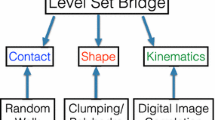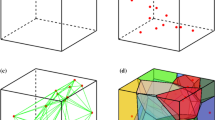Abstract
The Discrete Element Method is a popular method for modeling granular materials, however, it is typically limited to geometrically simple objects. A recent extension of this method, the Level Set Discrete Element Method (LS-DEM), overcomes this issue by allowing the use of any particle shape, including morphologically accurate computational grains generated from tomographic images. This method has the ability to provide insight into the physics of granular media that are challenging if granular shape morphology is not accurately represented. One challenge with fully utilizing LS-DEM is gathering the data necessary to reproduce the distinct shapes of grains. In this work, we develop a novel granular generation method that uses genetic algorithms to create new computational grains from a smaller set of input data. This method has the capability of building grains that match any well defined morphological property. We demonstrate the method by generating grains to match sphericity and principal curvature property distributions generated from an existing particle dataset captured with 3D X-Ray tomography.















Similar content being viewed by others
References
Cazals, F., Pouget, M.: Estimating differential quantities using polynomial fitting of osculating jets. Comput. Aided Geometric Des. 22(2), 121–146, (2005). ISSN 0167-8396. https://doi.org/10.1016/j.cagd.2004.09.004. URL http://www.sciencedirect.com/science/article/pii/S016783960400113X. Accessed 15 Jan 2017
Cho, G.-C., Dodds, J., Santamarina, J.C.: Particle shape effects on packing density, stiffness, and strength: natural and crushed sands. J. Geotech. Geoenviron. Eng. 132(5), 591–602 (2006)
Cil, M.B., Alshibli, K.A.: 3d assessment of fracture of sand particles using discrete element method. Geotech. Lett. 2(3), 161–166 (2012). https://doi.org/10.1680/geolett.12.00024
Cobo, A.X.J.: Microscopic origin of macroscopic strength in granular media: a numerical and analytical approach. PhD thesis, California Institute of Technology, 4 (2016)
Cundall, P.: Formulation of a three-dimensional distinct element model-part i. a scheme to detect and represent contacts in a system composed of many polyhedral blocks. Int. J. Rock Mech. Mini. Sci. Geomech. Abstr. 25(3), 107–116, (1988). ISSN 0148-9062. https://doi.org/10.1016/0148-9062(88)92293-0. URL http://www.sciencedirect.com/science/article/pii/0148906288922930. Accessed 15 Jan 2017
Cundall, P.A., Strack, O.D.: A discrete numerical model for granular assemblies. Geotechnique 29(1), 47–65 (1979)
De Jong, K.: Learning with genetic algorithms: an overview. Mach. Learn. 3(2), 121–138 (1988). https://doi.org/10.1007/BF00113894
De Rainville, F.-M., Fortin, F.-A., Gardner, M.-A., Parizeau, M., Gagné, C.: Deap: A python framework for evolutionary algorithms. In: Proceedings of the 14th Annual Conference Companion on Genetic and Evolutionary Computation, GECCO ’12, pp. 85–92, New York, NY, USA, 2012. ACM. ISBN 978-1-4503-1178-6. https://doi.org/10.1145/2330784.2330799
Fabri, A., Pion, S.: Cgal: The computational geometry algorithms library. In: Proceedings of the 17th ACM SIGSPATIAL International Conference on Advances in Geographic Information Systems, GIS ’09, pages 538–539, New York, NY, USA, (2009). ACM. ISBN 978-1-60558-649-6. https://doi.org/10.1145/1653771.1653865
Guo, P., Su, X.: Shear strength, interparticle locking, and dilatancy of granular materials. Can. Geotech. J. 44(5), 579–591 (2007). https://doi.org/10.1139/t07-010
Hyslip, J.P., Vallejo, L.E.: Fractal analysis of the roughness and size distribution of granular materials. Eng. Geol. 48(3-4), 231–244, (1997). ISSN 0013-7952. https://doi.org/10.1016/S0013-7952(97)00046-X. URL http://www.sciencedirect.com/science/article/pii/S001379529700046X. Fractals in Engineering Geology. Accessed 15 Jan 2017
Kawamoto, R., Andò, E., Viggiani, G., Andrade, J.E.: Level set discrete element method for three-dimensional computations with triaxial case study. J. Mech. Phys. Solids 91, 1–13 (2016)
Kruggel-Emden, H., Simsek, E., Rickelt, S., Wirtz, S., Scherer, V.: Review and extension of normal force models for the discrete element method. Powder Technol. 171(3), 157–173, (2007). ISSN 0032-5910. https://doi.org/10.1016/j.powtec.2006.10.004. URL http://www.sciencedirect.com/science/article/pii/S0032591006004360. Accessed 15 Jan 2017
Lim, K.-W., Krabbenhoft, K., Andrade, J.E.: On the contact treatment of non-convex particles in the granular element method. Comput. Part. Mech. 1(3), 257–275 (2014). https://doi.org/10.1007/s40571-014-0019-2
Neil, B., Russ, J.: Measuring Shape. CRC Press, Boca Raton (2012)
Riley, H.B.: Mathematical Methods for Physics and Engineering. Cambridge University Press, Cambridge (2006)
Sperl, M.: Experiments on corn pressure in silo cells—translation and comment of janssen’s paper from: Granular Matter, 8(2), 59–65, (2006). ISSN 1434–7636, (1895). https://doi.org/10.1007/s10035-005-0224-z
Vu-Quoc, L., Zhang, X., Walton, O.: A 3-d discrete-element method for dry granular flows of ellipsoidal particles. Comput. Methods Appl. Mech. Eng. 187(3), 483–528, (2000). ISSN 0045-7825. https://doi.org/10.1016/S0045-7825(99)00337-0
Wadell, H.: Volume, shape, and roundness of quartz particles. J. Geol. 43(3), 250–280, (1935). ISSN 00221376, 15375269. URL http://www.jstor.org/stable/30056250. Accessed 15 Jan 2017
Wold, S., Esbensen, K., Geladi, P.: Principal component analysis. Chemom. Intell. Lab. Syst. 2(1), 37–52, (1987). ISSN 0169-7439. https://doi.org/10.1016/0169-7439(87)80084-9. URL http://www.sciencedirect.com/science/article/pii/0169743987800849. Accessed 15 Jan 2017
Zhao, B., Wang, J.: 3d quantitative shape analysis on form, roundness, and compactness with \(\mu CT\). Powder Technol. 291, 262–275, (2016). ISSN 0032-5910. https://doi.org/10.1016/j.powtec.2015.12.029. URL http://www.sciencedirect.com/science/article/pii/S0032591015302345. Accessed 20 July 2018
Zhou, B., Wang, J.: Generation of a realistic 3d sand assembly using x-ray micro-computed tomography and spherical harmonic-based principal component analysis. Int. J. Numer. Analy. Methods Geomech. (2016). ISSN 1096-9853. https://doi.org/10.1002/nag.2548
Acknowledgements
Research was sponsored by the Army Research Office and was accomplished under Grant Number W911NF-17-1-0212. The views and conclusions contained in this document are those of the authors and should not be interpreted as representing the official policies, either expressed or implied, of the Army Research Office or the U.S. Government. The U.S. Government is authorized to reproduce and distribute reprints for Government purposes notwithstanding any copyright notation herein.
Author information
Authors and Affiliations
Corresponding author
Ethics declarations
Conflict of interest
The authors declare that they have no conflict of interest.
Rights and permissions
About this article
Cite this article
Buarque de Macedo, R., Marshall, J.P. & Andrade, J.E. Granular object morphological generation with genetic algorithms for discrete element simulations. Granular Matter 20, 73 (2018). https://doi.org/10.1007/s10035-018-0845-7
Received:
Published:
DOI: https://doi.org/10.1007/s10035-018-0845-7




